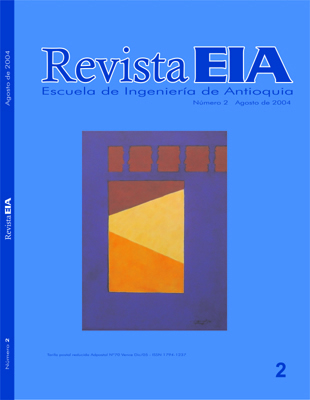FACTIBILIDAD DE DISPOSICIÓN DE LOS BIOS”LIDOS GENERADOS EN UNA PLANTA DE TRATAMIENTO DE AGUAS RESIDUALES COMBINADA
FACTIBILIDAD DE DISPOSICIÓN DE LOS BIOS”LIDOS GENERADOS EN UNA PLANTA DE TRATAMIENTO DE AGUAS RESIDUALES COMBINADA


This work is licensed under a Creative Commons Attribution-NonCommercial-NoDerivatives 4.0 International License.
Copyright statement
The authors exclusively assign to the Universidad EIA, with the power to assign to third parties, all the exploitation rights that derive from the works that are accepted for publication in the Revista EIA, as well as in any product derived from it and, in in particular, those of reproduction, distribution, public communication (including interactive making available) and transformation (including adaptation, modification and, where appropriate, translation), for all types of exploitation (by way of example and not limitation : in paper, electronic, online, computer or audiovisual format, as well as in any other format, even for promotional or advertising purposes and / or for the production of derivative products), for a worldwide territorial scope and for the entire duration of the rights provided for in the current published text of the Intellectual Property Law. This assignment will be made by the authors without the right to any type of remuneration or compensation.
Consequently, the author may not publish or disseminate the works that are selected for publication in the Revista EIA, neither totally nor partially, nor authorize their publication to third parties, without the prior express authorization, requested and granted in writing, from the Univeridad EIA.
Show authors biography
Por medio de dos pruebas piloto, la Escuela de Ingeniería de Antioquia y la Universidad Pontificia Bolivariana, con el apoyo de Empresas Públicas de Medellín, se propusieron determinar la factibilidad dedisposición de los biosólidos provenientes de la planta de tratamiento de aguas residuales San Fernando,considerándolos como potenciales rehabilitadores de suelos degradados y como materiales de compostaje.
Las pruebas realizadas en la investigación incluyeron la caracterización fisicoquímica y microbiológicadel biosólido, la cual permitió establecer la no peligrosidad del material bajo los criterios de corrosividad, reactividad, explosividad, toxicidad e inflamabilidad; la identificación de aportes de sustancias al medio por la aplicación de los biosólidos en suelos degradados y el establecimiento de las tasas más recomendadas deaplicación directa para la rehabilitación de áreas degradadas en el trópico en lugares donde no se establecen cultivos ni se adelanten actividades de ganaderÌa. De igual forma se determinó el potencial del biosÛlidocomo material susceptible de compostaje, la evaluación del proceso y los materiales más recomendados; se obtuvo un material de excelente calidad orgánica que aporta nutrientes. Pese a lo anterior, se debe aclarar que el material presenta organismos patógenos y una carga alta de cromo, lo que debe tenerse en cuenta a la hora de usarlo directamente; además, para el caso del compost, se supera la carga de cromo encontrada en recomendaciones de la normatividad colombiana.
Abstract: By means of two pilot tests, Antioquia School of Engineering and Pontifical Bolivarian University , withthe support of Public Service Enterprises of MedellÌn, decided to determine the feasibility for disposition ofbiosolids originating from the residual water treatment plant San Fernando considering them as potentialrehabilitators for degraded soils and composting materials. The tests made in the research included thephysicochemical and microbiological characterization of the biosolid, which allowed to establish that thematrial is not dangerous under criteria of corrosivity, reactivity, explosivity, toxicity, and inflammability; the identification of contributions of substances to environment by the application of biosolids in degraded soilsand the establishment of the most recommended rates of direct application for the rehabilitation of degraded areas in the tropic, in places without cultures or cattle activities. Similarly, it was determined the potential of thebiosolid as susceptible material for composting, the evaluation of the process and the most recommended materials, having as result an excellent organic quality material which provides with nutrients. In spite of that,it is due to clarify that the material presents pathogenic organisms and a high chromium load which mustconsider at the time of using directly this material; additionaly, for the case of compost, it is exceeded thechromium load accepted by the Colombian regulation.
Article visits 247 | PDF visits 226
